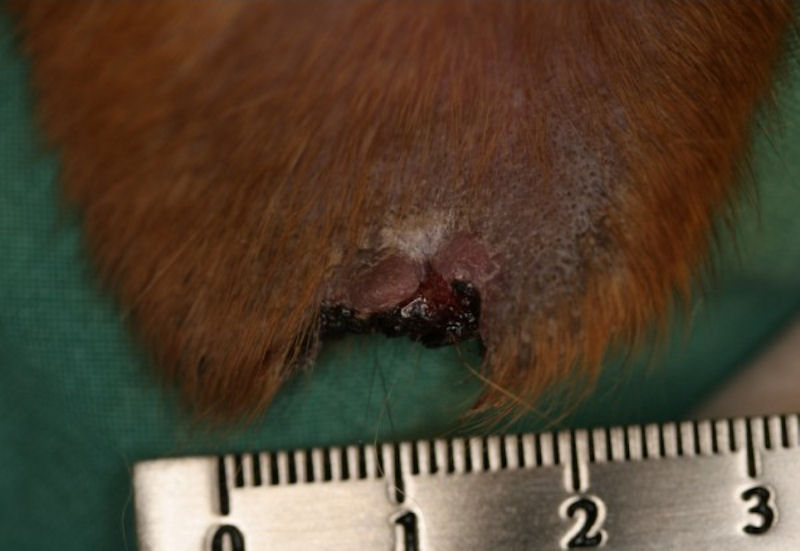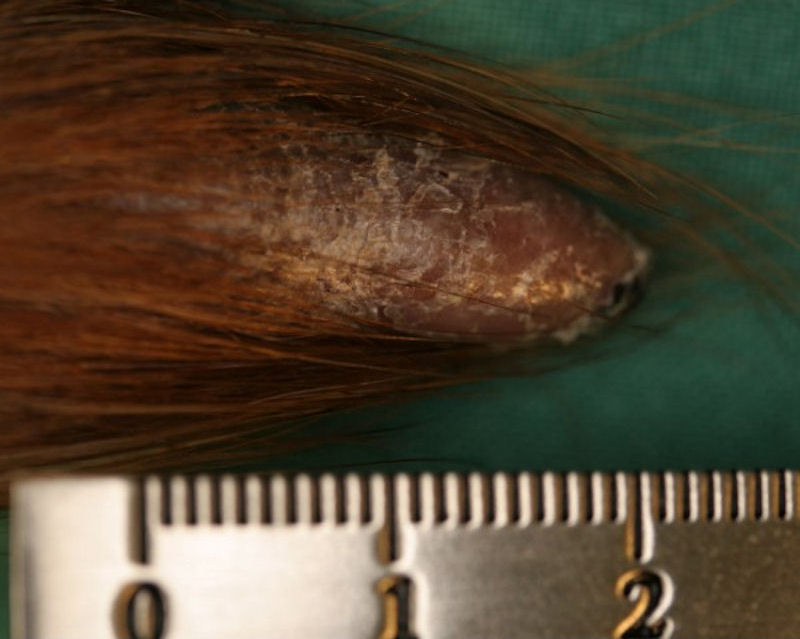Cutaneous vasculitis
Introduction
- Vasculitis is defined as a disease process characterized by inflammation of the blood vessel wall and subsequent destruction of vessels resulting in ischemia.
- It is a rare disease in dogs.
- Vasculitis is usually classified according to the histological inflammatory pattern, and most cases affect the small cutaneous vessels.
Presenting signs
- Ulcers and crusted lesions, especially involving the paws, pinnae
 , lips, tail
, lips, tail  , footpads and oral mucosa.
, footpads and oral mucosa.
- Purpura, hemorrhagic bullae, and areas of alopecia.
Acute presentation
- Development of lesions and course of the disease depends on the underlying disease.
- Many cases, however, are idiopathic.
Geographic incidence
- No geographical predilection except in some cases with an infectious cause, eg tick borne diseases.
Age predisposition
- No age predisposition.
Breed/Species predisposition
- No breed predilection.
Public health considerations
- None, except in cases that have an infectious underlying cause.
Cost considerations
- Cost would depend on the underlying cause triggering the vasculitis.
- Investigating the underlying cause, and immunosuppressive, immunomodulating and vasoactive treatments can be expensive.
Special risks
- Not applicable.
Pathogenesis
Etiology
- Any foreign antigen capable of triggering an immune response should be considered as a potential cause, including infectious organisms (bacterial, mycobacterial, viral, rickettsial, fungal), neoplasia, drugs and foods, and autoimmune diseases, eg lupus vasculitis.
Predisposing factors
General- Vasculitis is not a specific diagnosis.
- It is important to investigate etiological possibilities.
- 50% or more of cases appear to be idiopathic.
Pathophysiology
- The most commonly accepted mechanism of vasculitis is type III hypersensitivity.
- Soluble circulating antigen-antibody immune complexes (formed in antigen excess) become blocked in blood vessel endothelium.
- Complement activation via the classic pathway follows and the C5a component of complement triggers polymorphonuclear cell recruitment to the vessel wall.
- Leukocytes infiltrate the blood vessel wall and release lysosomal enzymes damaging the endothelial cells.
- Fibrin deposition leads to thrombosis and tissue necrosis.
Timecourse
- It depends on the underlying cause and the severity of the hypersensitivity developed by the individual.
Diagnosis
Subscribe To View
This article is available to subscribers.
Try a free trial today or contact us for more information.
Treatment
Subscribe To View
This article is available to subscribers.
Try a free trial today or contact us for more information.
Prevention
Subscribe To View
This article is available to subscribers.
Try a free trial today or contact us for more information.
Outcomes
Subscribe To View
This article is available to subscribers.
Try a free trial today or contact us for more information.
Further Reading
Publications
Refereed papers
- Recent references from PubMed and VetMedResource.
- Nichols P R, Morris D O & Beale K M (2001) A retrospective study of canine and feline cutaneous vasculitis. Vet Dermatol 12 (5), 255-264 PubMed.